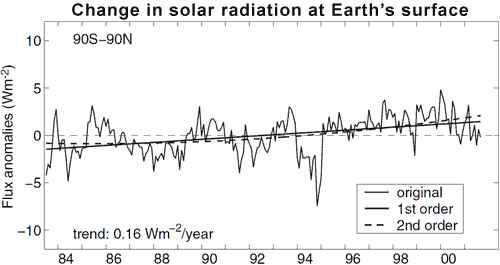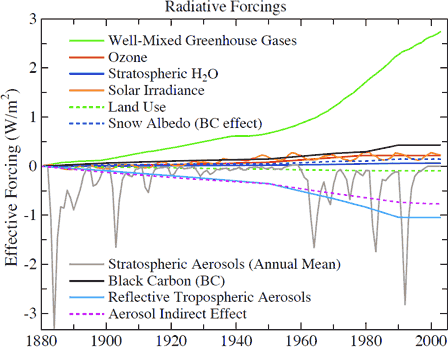Could global brightening be causing global warming?
What the science says...
Global brightening is caused by changes in cloud cover, reflective aerosols and absorbing aerosols. While changes in cloud cover & aerosols lead to more sunlight hitting the surface, this can be compensated by the cooling effect on the atmosphere due to fewer clouds trapping less warmth and fewer absorbing aerosols absorbing less sunlight.
Climate Myth...
It's global brightening
'...satellites confirmed measurements from ground stations show a considerable, and naturally-occurring, global brightening from 1983-2001 (Pinker et al., 2005). Elementary radiative-transfer calculations demonstrate that a natural surface global brightening amounting to ~1.9 Wm–2 over the 18-year period of study would be expected – using the IPCC’s own methodology – to have caused a transient warming of 1 K (1.8 F°). To put this naturally-occurring global brightening into perspective, the IPCC’s estimated total of all the anthropogenic influences on climate combined in the 256 years 1750-2005 is only 1.6 Wm–2.' (Christopher Monckton)
One skeptic argument, employed by Christopher Monckton in his testimony to US Congress, is that global brightening is the cause of global warming. From 1983 to 2001, the amount of sunlight hitting the Earth's surface has increased by 1.9 W/m2. Monckton compares this to the radiative forcing from manmade influence since pre-industrial times, estimated at 1.6 W/m2 (IPCC AR4). Monckton argues that these numbers prove global brightening is responsible for recent global warming. But is this the full picture?
Monckton's numbers come from Do Satellites Detect Trends in Surface Solar Radiation? (Pinker et al 2005). This study analyses satellite measurements of solar radiation, upward radiation from the Earth and cloud cover fraction to model the amount of sunlight reaching the Earth's surface. They calculate an overall increase in surface solar radiation of 0.16 W/m2 per year. Once the satellite data is corrected to remove an orbital decay bias (ERBE 2005), Monckton calculates a net increase in surface radiative flux of 1.9 W/m2.

Figure 1: Changes in solar radiation at the Earth's surface from 1983 to 2001. Solid line is linear fit, dotted line is quadratic fit. The linear slope (solid line) is positive at 0.16 W/m2 per year (Pinker et al 2005).
Is it valid to compare changes in surface solar radiation to radiative forcing? A good person to answer this is Rachel Pinker herself who in responding to Monckton's argument, said the following:
'The CO2 "radiative forcing" value that Mr. Christopher Monckton is quoting refers to the impact on the Earth’s Radiative balance as described above. The numbers that we quote in our paper represent the change in surface SW due to changes in the atmosphere (clouds, water vapor, aerosols). These two numbers cannot be compared at their face value.'
Why can't you compare the two numbers? Radiative forcing refers to a disturbance in the planet's energy balance. Forcings change the balance between incoming sunlight and outgoing radiation at the top of the atmosphere, causing the planet to lose or gain energy. Global temperatures will only respond to surface brightening if the total amount of solar energy absorbed by our climate system changes. To determine this, we need to understand what's causing global brightening.
There are three major contributors: a reduction in cloud cover, a reduction in scattering aerosols such as sulfates and a reduction in absorbing aerosols like soot (Wild 2009). Scattering aerosols reflect incoming sunlight, preventing it from reaching the Earth's surface. As the amount of sulfate pollution in the atmosphere lessens, more sunlight reaches the surface. If this was the sole cause of global brightening, then the increase in surface solar radiation would equal the extra energy absorbed by our climate (eg - the radiative forcing).
However, changes in cloud cover and absorbing aerosols also contribute to global brightening. As well as reflect sunlight, clouds trap infrared radiation coming up from the surface. So while less clouds allow more sunlight to reach the surface which has a warming effect, they also let more infrared radiation escape to space which has a cooling effect.
Similarly, a decline in absorbing aerosols like soot means more sunlight reaches the Earth which has a warming effect. But they also absorb sunlight which warms the atmosphere so a decline in absorbing aerosols also has a cooling effect. Absorbing aerosols like black carbon have shown a large decreasing trend since the 1980s (Wild 2009).
To focus solely on the amount of sunlight hitting the Earth doesn't give you the full picture of global brightening. As absorbing aerosols and clouds are contributing factors, the change in surface solar radiation is expected to be much more than the net radiative forcing from global brightening. To gain a fuller understanding of climate, we need to consider all the various forcings together rather than take one small piece in isolation. These include the direct effect from reflective aerosols, the indirect effect of aerosols on cloud cover and the effect of absorbing aerosols (black carbon) to name just a few.

Figure 2: Separate global climate forcings relative to their 1880 values (GISS).
Figure 2 demonstrates that CO2 is not the only driver of climate. Nevertheless, it's clear that man-made greenhouse gases (of which CO2 is the greatest contributor) is currently the most dominant forcing and increasing faster than any other forcing.
Last updated on 29 October 2016 by dana1981. View Archives































 Arguments
Arguments
































I agree with your article
so the global brightening is caused by changes in cloud cover, a cloud is an aerosol comprising a visible mass of minute liquid droplets, frozen crystals, or particles suspended in the atmosphere so the major one that absorbing all the radiation in our atmosphere is cloud and aerosol, aerosol can absorb the solar radiation so if we decline in absorbing aerosol so that means sunlight will reach the earth so the result is our Earth is warmer than before.
Cloud also take a major character because clouds can trap the infrared radiation So if we have less cloud infrared radiation will come directly to us so the result is our surface warmer than before. From the graph, you bring I can understand all of that information.
How can we prevent the infrared radiation when the cloud and aerosol all gone?
Thanapat, clouds and aerosols do not absorb solar radiation, they reflect it.
Cloud behavior is complex, and clouds have both warming and cooling effects: clouds traps heat beneath them, but they also reflect light back to space. The main effect of thick, low clouds is cooling; the main effect of high, thin clouds is warming.
Here, the important thing about clouds is that scientists have determined (after many years of study) that clouds will not change very much as the climate changes. So their effect on climate change will be small (though clouds will most likely act as an amplifying feedback).
Fossil fuels cause global warming via CO2 (and NO2), but fossil fuels also cause aerosols (via SO2). If humans stop burning fossil fuels, the aerosols will dissipate immediately, but the CO2 will not. Unfortunately, this may cause global temperatures to increase slightly after we stop burning fossil fuels.
Infrared radiation is normal. Almost everything on earth emits infrared. The important thing to understand is that greenhouse gases glow in infrared—they send down infrared light from the sky. Reducing greenhouse gases is like removing a blanket, it lets heat escape to space more easily. To reduce greenhouse gases, we can:
Correction: some aerosols do absorb solar radiation (which in fact warms up the atmosphere, and I don't know whether this causes more/less warming at ground level than sunlight hitting the ground. "Global brightening" is not a useful concept w.r.t. climate change; it creates a distinction between sunlight warming the ground and solar-induced infrared/warm air warming the ground, which is not an important distinction.)
Dpiepgrass et al:
The aerosol property of interest is the "single scattering albedo". Overall, any reduction in radiation is referred to as "attenuation". What was travelling in a direct line is no longer travelling along that direct line. It can be absorbed, or it can be scattered (now travelling in a different direction).
Scattering occurs in all directions, For scattering, some is back-scattered (the vector is at least partially opposite to the original direction of travel) and some is forward-scattered (the vector is at least partially in the same direction as the original direction of travel).
Things like soot are strongly absorbing. Things like dust are strongly scattering.
Atmospheric attentuation is easily measured by instruments pointed at the sun (sun photometers). Figuring out how much is absorbed and how much is scattered is a little trickier, but done routinely by international networks such as AeroNet.
I presume that 'you' have seen this?
http://www.bbc.co.uk/sn/tvradio/programmes/horizon/dimming_trans.shtml
A BBC documentary about how unintentional increased reflectance due to man made pollution has actually hidden the affects of increased carbon dioxide in the atmosphere.